SAMSUNG LCD电视机LS15S13C使用说明书
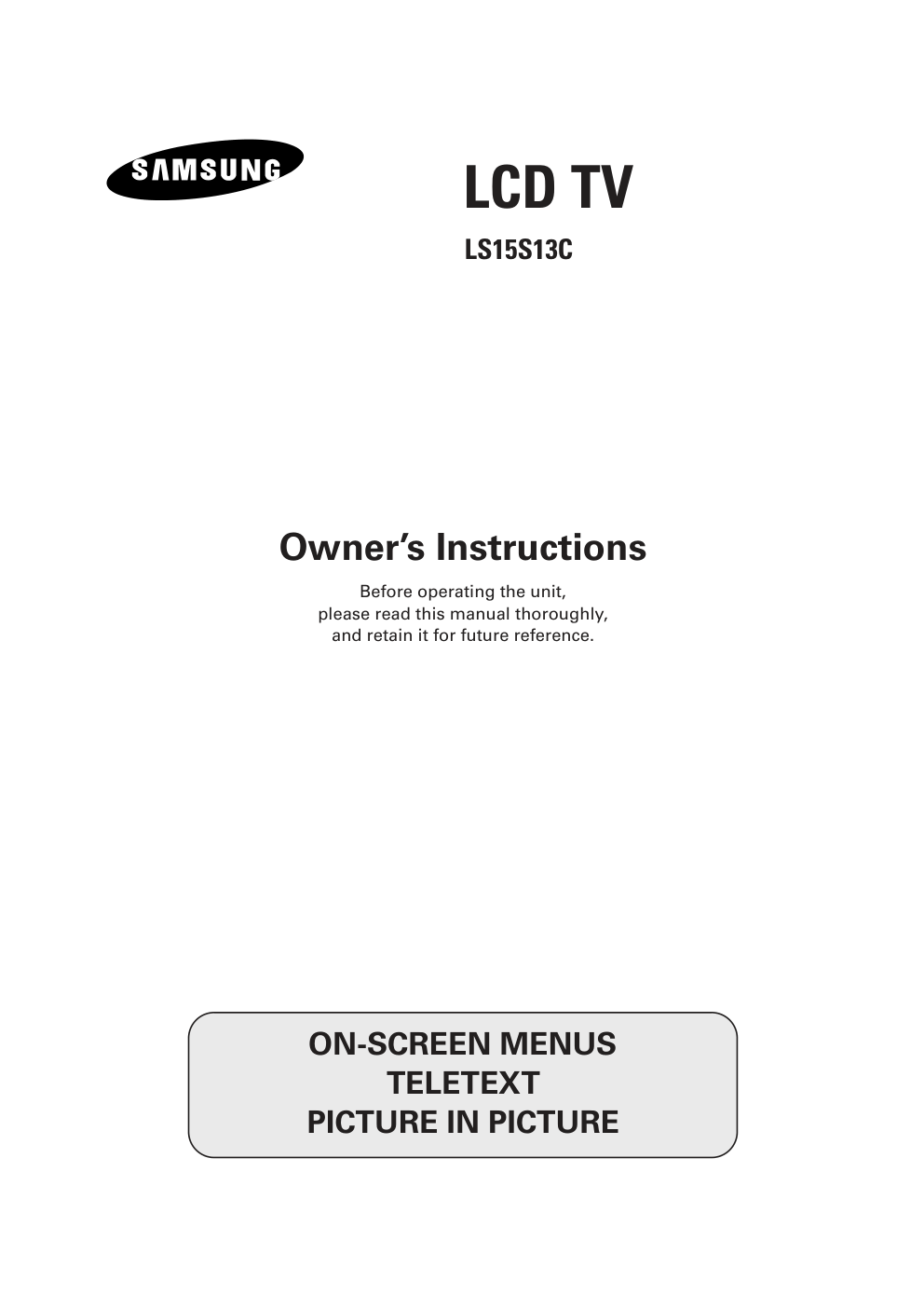)
)
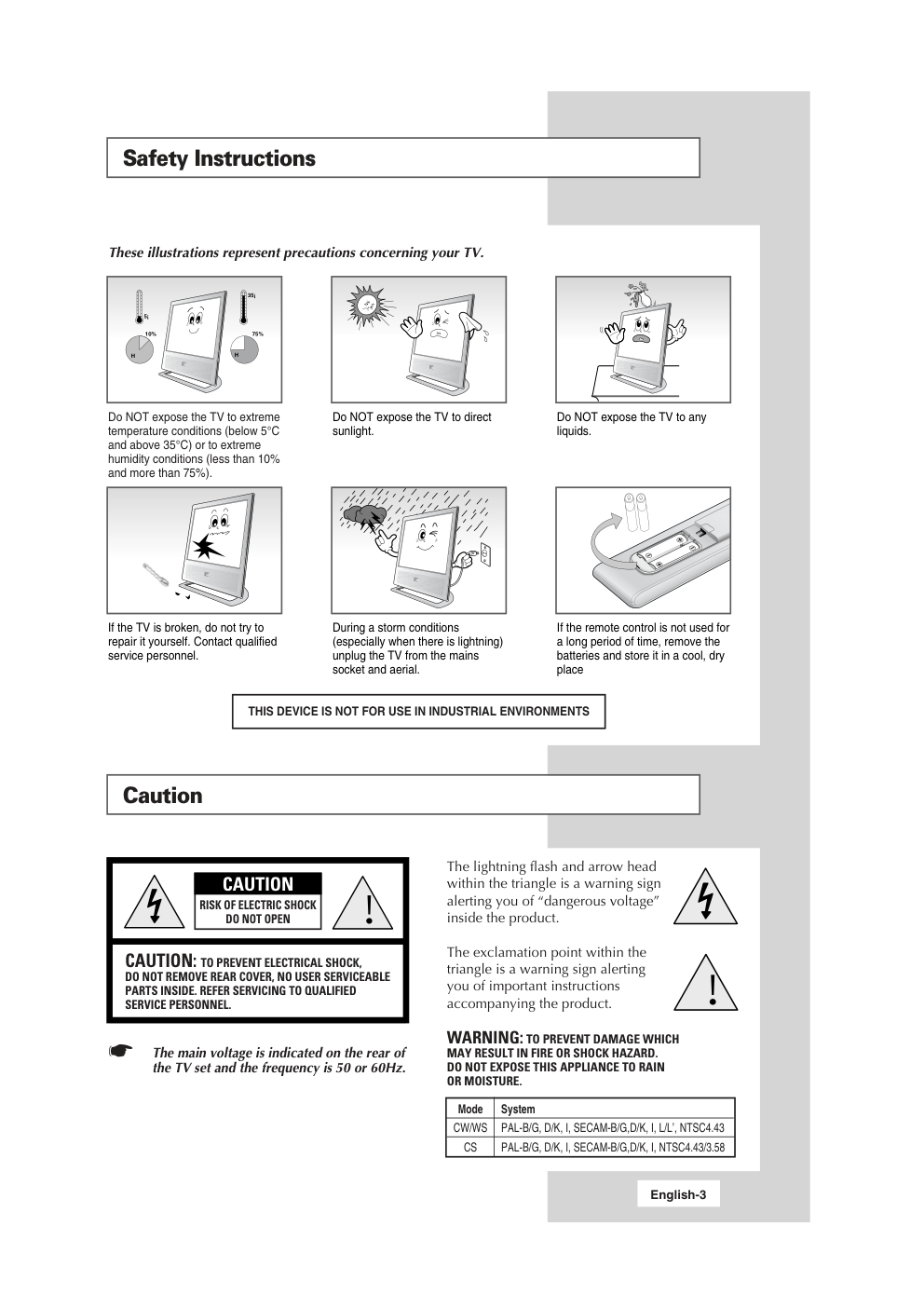)
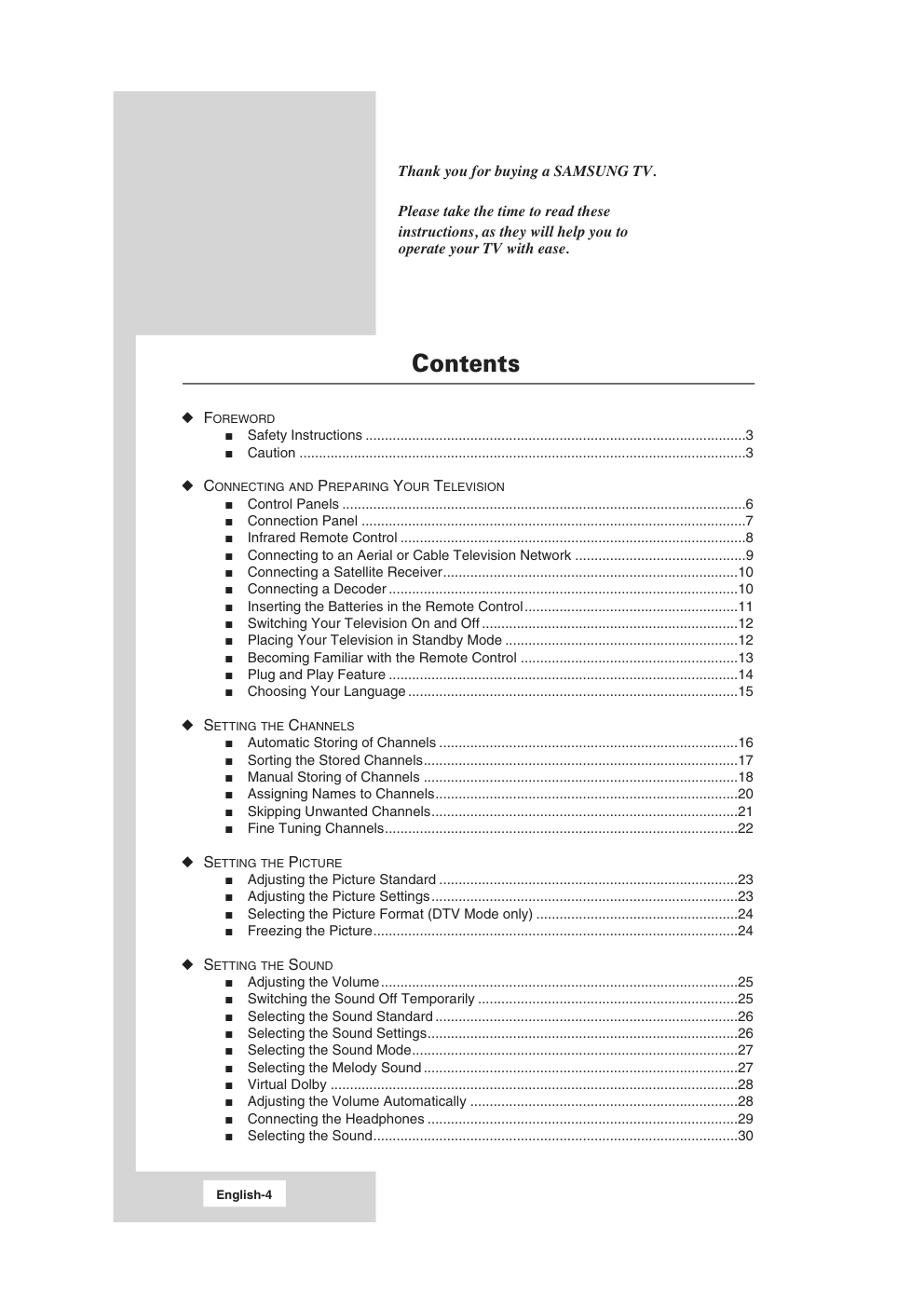)
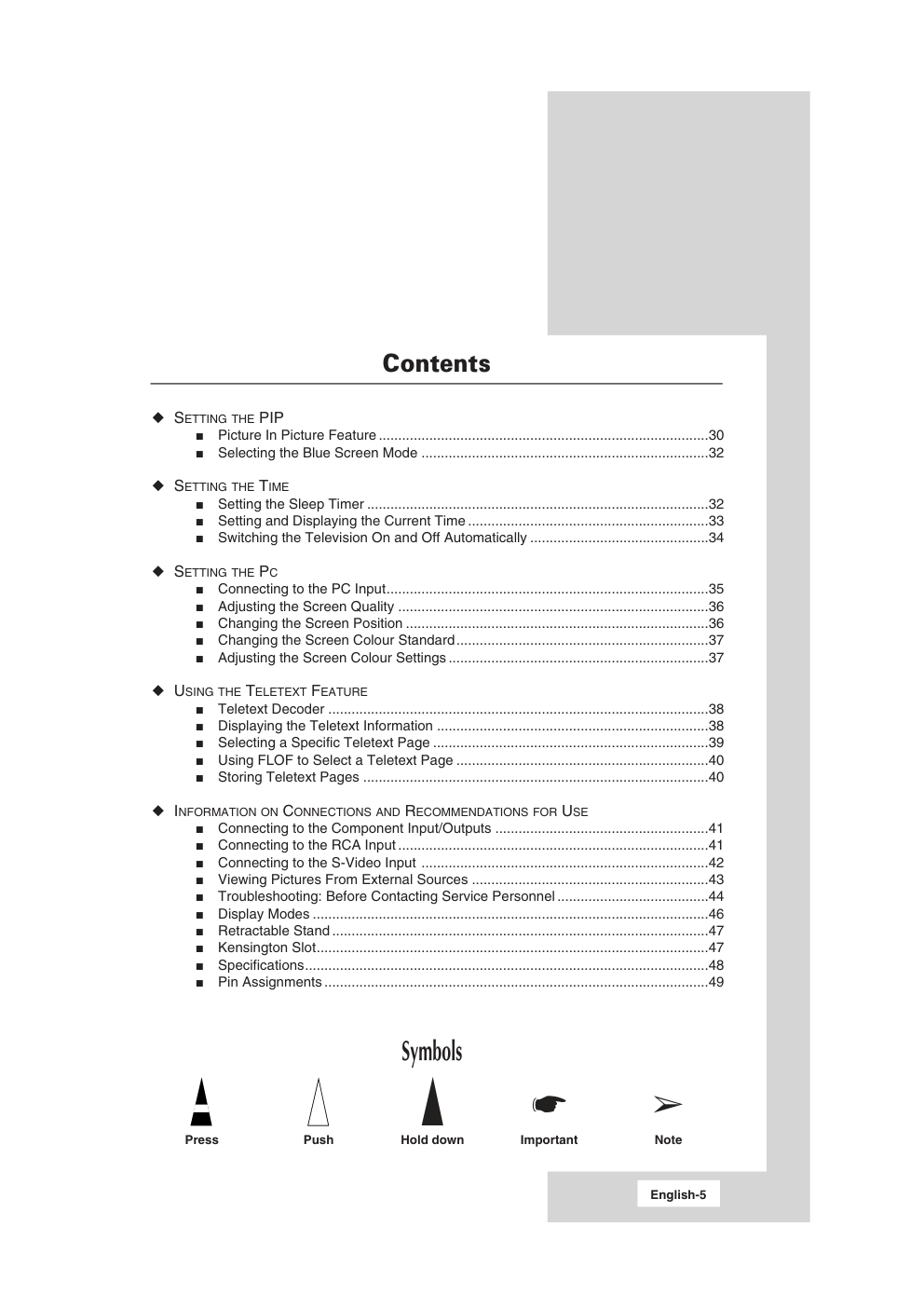)
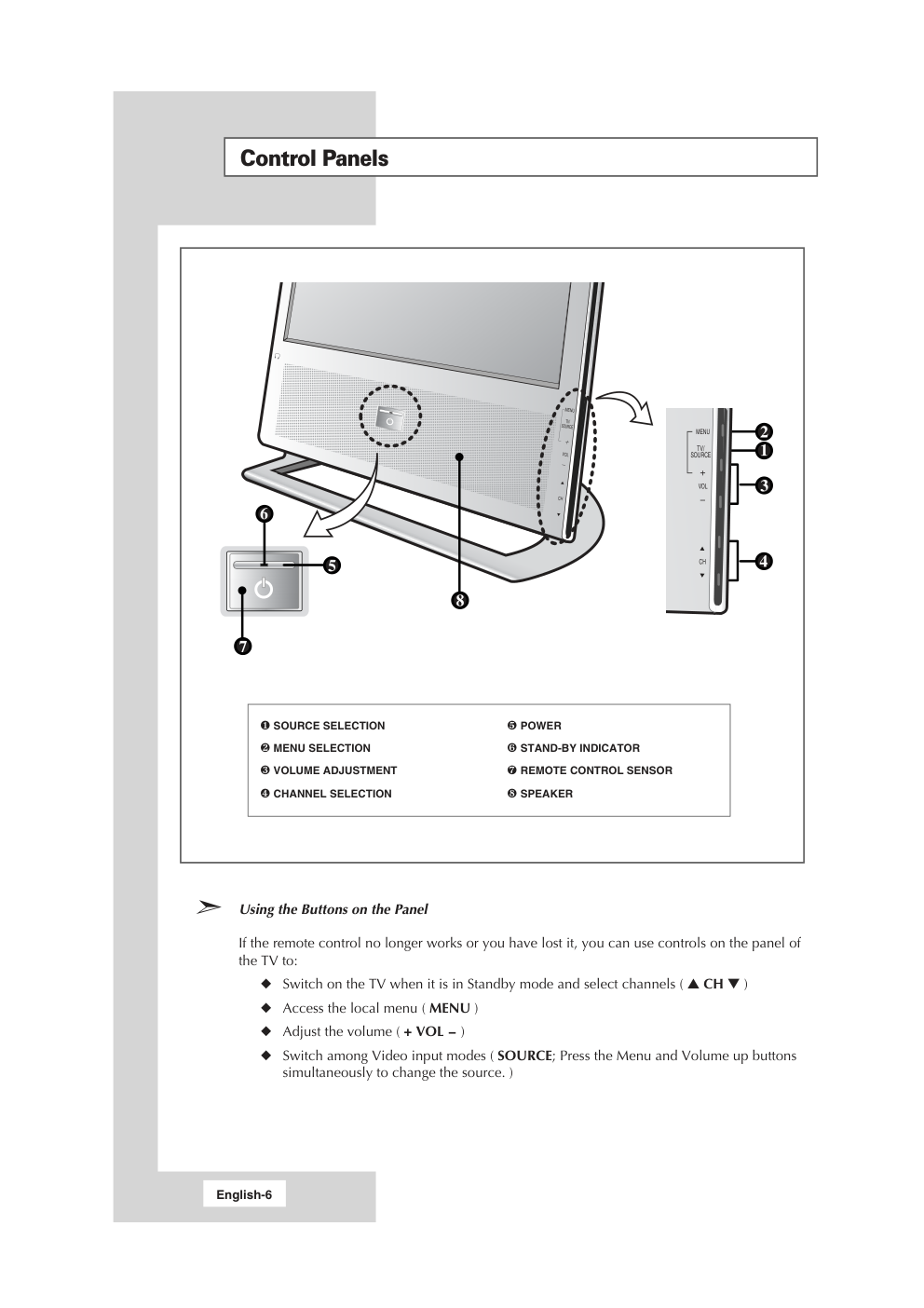)
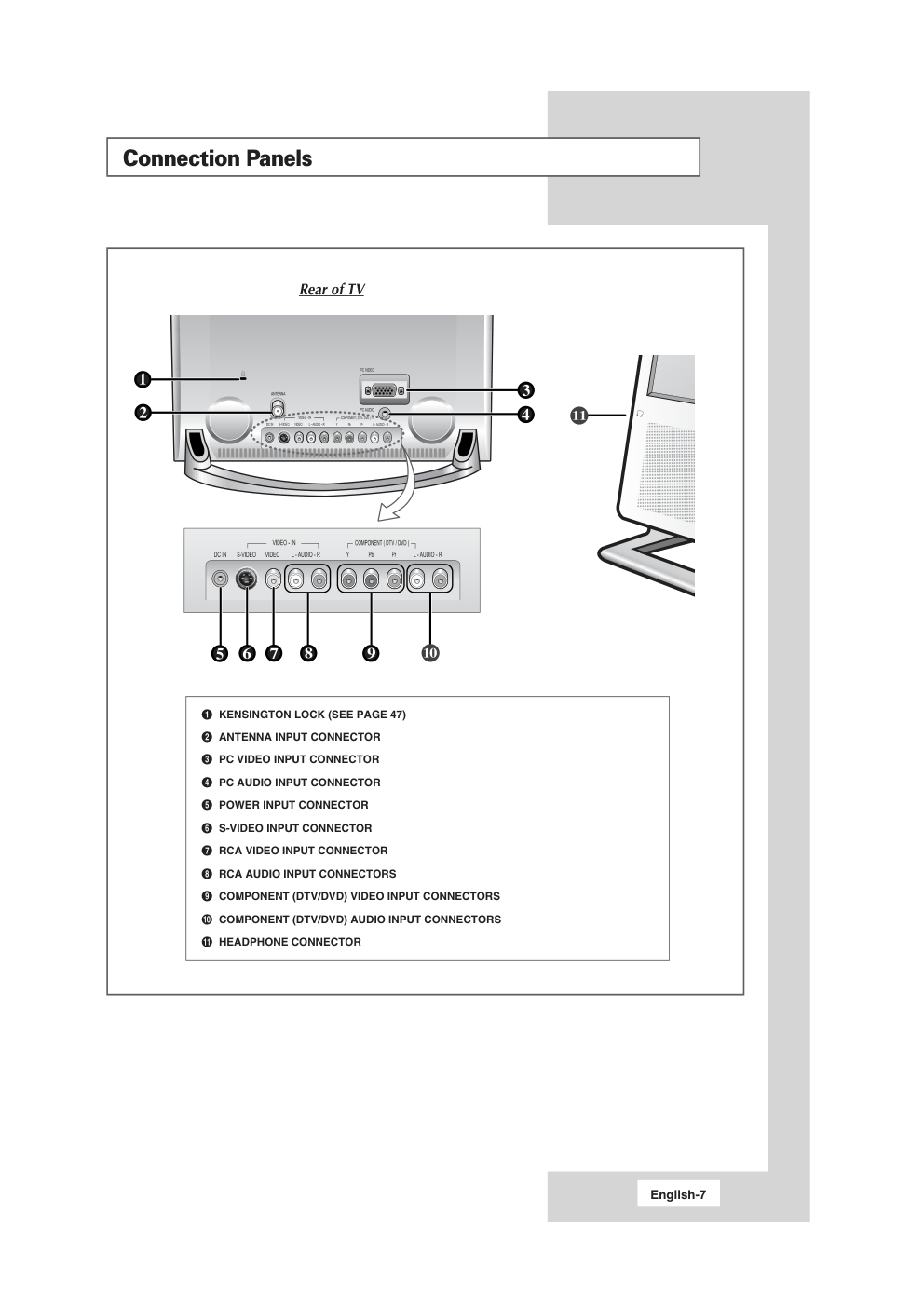)
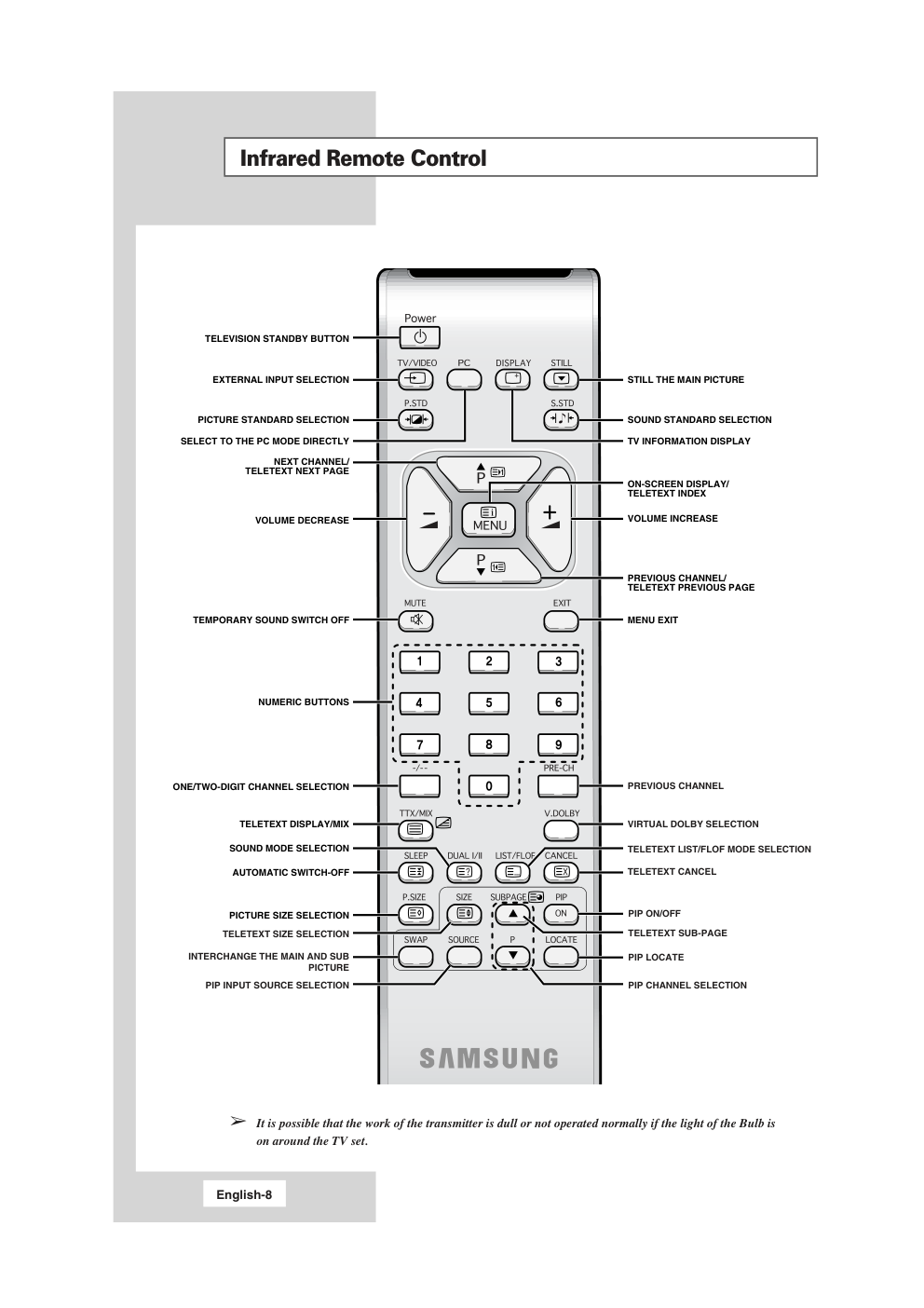)
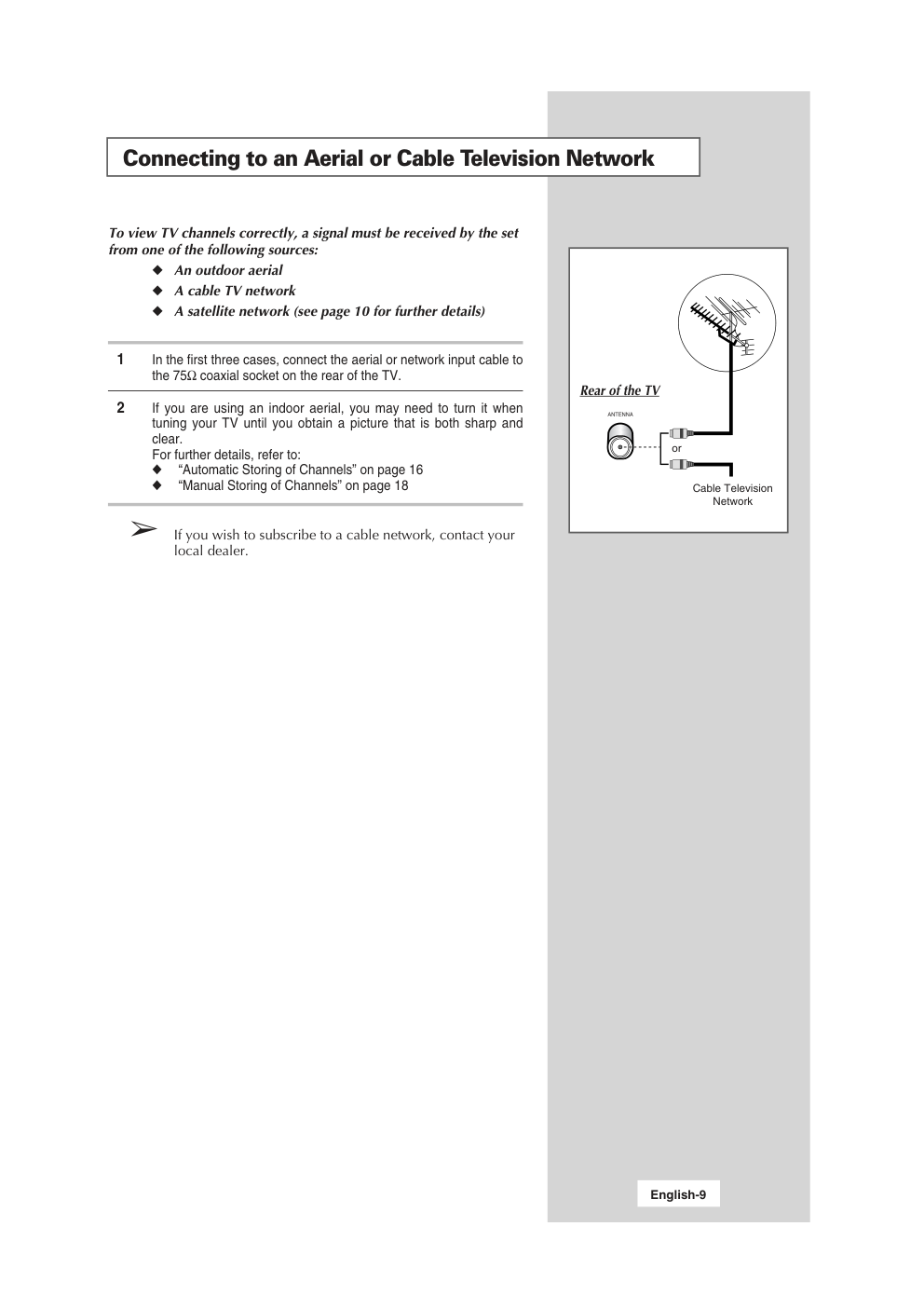)
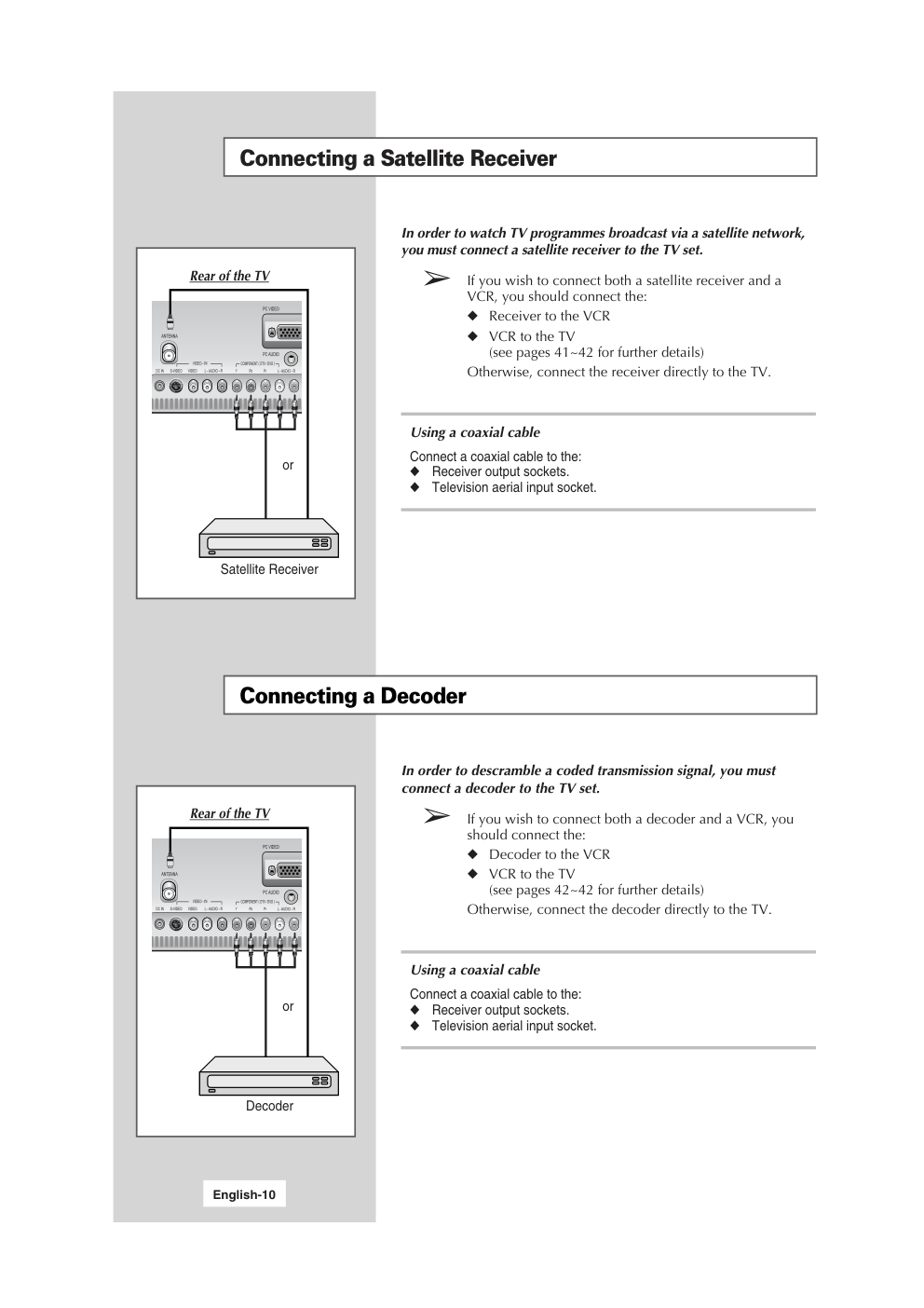)
LCD TV Owner’s Instructions Before operating the unit, please read this manual thoroughly, and retain it for future reference. ON-SCREEN MENUS TELETEXT PICTURE IN PICTURE LS15S13C English-2 Information in this document is subject to change without notice. © 2002 Samsung Electronics Co., Ltd. All rights reserved. Reproduction in any manner whatsoever without the written permission of Samsung Electronics Co., Ltd. is strictly forbidden. Samsung Electronics Co., Ltd. shall not be liable for errors contained herein or for incidental or consequential damages in connection with the furnishing, performance, or use of this material. The Samsung logo is the registered trademarks of Samsung Electronics Co., Ltd.; VESA, DPMS and DDC are registered trademarks of Video Electronics Standard Association; the ENERGY STAR name and logo are registered trademarks of the U.S. Environmental Protection Agency (EPA). As an ENERGY STAR Partner, Samsung Electronics Co., Ltd. has determined that this product meets the ENERGY STAR guidelines for energy efficiency. All other product names mentioned herein may be the trademarks or registered trademarks of their respective owners. Safety Instructions English-3 5¡ 10% H 35¡ H 75% These illustrations represent precautions concerning your TV. Do NOT expose the TV to extreme temperature conditions (below 5°C and above 35°C) or to extreme humidity conditions (less than 10% and more than 75%). Do NOT expose the TV to direct sunlight. Do NOT expose the TV to any liquids. If the TV is broken, do not try to repair it yourself. Contact qualified service personnel. During a storm conditions (especially when there is lightning) unplug the TV from the mains socket and aerial. If the remote control is not used for a long period of time, remove the batteries and store it in a cool, dry place THIS DEVICE IS NOT FOR USE IN INDUSTRIAL ENVIRONMENTS ☛ The main voltage is indicated on the rear of the TV set and the frequency is 50 or 60Hz. CAUTION: TO PREVENT ELECTRICAL SHOCK, DO NOT REMOVE REAR COVER, NO USER SERVICEABLE PARTS INSIDE. REFER SERVICING TO QUALIFIED SERVICE PERSONNEL. RISK OF ELECTRIC SHOCK DO NOT OPEN ! CAUTION The lightning flash and arrow head within the triangle is a warning sign alerting you of “dangerous voltage” inside the product. The exclamation point within the triangle is a warning sign alerting you of important instructions accompanying the product. WARNING: TO PREVENT DAMAGE WHICH MAY RESULT IN FIRE OR SHOCK HAZARD. DO NOT EXPOSE THIS APPLIANCE TO RAIN OR MOISTURE. ! Mode System CW/WS PAL-B/G, D/K, I, SECAM-B/G,D/K, I, L/L’, NTSC4.43 CS PAL-B/G, D/K, I, SECAM-B/G,D/K, I, NTSC4.43/3.58 Caution English-4 Contents N FOREWORD I Safety Instructions ..................................................................................................3 I Caution ...................................................................................................................3 N CONNECTING AND PREPARING YOUR TELEVISION I Control Panels ........................................................................................................6 I Connection Panel ...................................................................................................7 I Infrared Remote Control .........................................................................................8 I Connecting to an Aerial or Cable Television Network ............................................9 I Connecting a Satellite Receiver............................................................................10 I Connecting a Decoder ..........................................................................................10 I Inserting the Batteries in the Remote Control.......................................................11 I Switching Your Television On and Off ..................................................................12 I Placing Your Television in Standby Mode ............................................................12 I Becoming Familiar with the Remote Control ........................................................13 I Plug and Play Feature ..........................................................................................14 I Choosing Your Language .....................................................................................15 N SETTING THE CHANNELS I Automatic Storing of Channels .............................................................................16 I Sorting the Stored Channels.................................................................................17 I Manual Storing of Channels .................................................................................18 I Assigning Names to Channels..............................................................................20 I Skipping Unwanted Channels...............................................................................21 I Fine Tuning Channels...........................................................................................22 N SETTING THE PICTURE I Adjusting the Picture Standard .............................................................................23 I Adjusting the Picture Settings...............................................................................23 I Selecting the Picture Format (DTV Mode only) ....................................................24 I Freezing the Picture..............................................................................................24 N SETTING THE SOUND I Adjusting the Volume............................................................................................25 I Switching the Sound Off Temporarily ...................................................................25 I Selecting the Sound Standard ..............................................................................26 I Selecting the Sound Settings................................................................................26 I Selecting the Sound Mode....................................................................................27 I Selecting the Melody Sound .................................................................................27 I Virtual Dolby .........................................................................................................28 I Adjusting the Volume Automatically .....................................................................28 I Connecting the Headphones ................................................................................29 I Selecting the Sound..............................................................................................30 Thank you for buying a SAMSUNG TV. Please take the time to read these instructions, as they will help you to operate your TV with ease. English-5 Contents N SETTING THE PIP I Picture In Picture Feature .....................................................................................30 I Selecting the Blue Screen Mode ..........................................................................32 N SETTING THE TIME I Setting the Sleep Timer ........................................................................................32 I Setting and Displaying the Current Time ..............................................................33 I Switching the Television On and Off Automatically ..............................................34 N SETTING THE PC I Connecting to the PC Input...................................................................................35 I Adjusting the Screen Quality ................................................................................36 I Changing the Screen Position ..............................................................................36 I Changing the Screen Colour Standard.................................................................37 I Adjusting the Screen Colour Settings ...................................................................37 N USING THE TELETEXT FEATURE I Teletext Decoder ..................................................................................................38 I Displaying the Teletext Information ......................................................................38 I Selecting a Specific Teletext Page .......................................................................39 I Using FLOF to Select a Teletext Page .................................................................40 I Storing Teletext Pages .........................................................................................40 N INFORMATION ON CONNECTIONS AND RECOMMENDATIONS FOR USE I Connecting to the Component Input/Outputs .......................................................41 I Connecting to the RCA Input ................................................................................41 I Connecting to the S-Video Input ..........................................................................42 I Viewing Pictures From External Sources .............................................................43 I Troubleshooting: Before Contacting Service Personnel .......................................44 I Display Modes ......................................................................................................46 I Retractable Stand .................................................................................................47 I Kensington Slot.....................................................................................................47 I Specifications........................................................................................................48 I Pin Assignments ...................................................................................................49 Press Push ☛ ➢ Symbols Important Note Hold down English-6 Control Panels ➣ Using the Buttons on the Panel If the remote control no longer works or you have lost it, you can use controls on the panel of the TV to: N Switch on the TV when it is in Standby mode and select channels ( L CH M ) N Access the local menu ( MENU ) N Adjust the volume ( + VOL - ) N Switch among Video input modes ( SOURCE; Press the Menu and Volume up buttons simultaneously to change the source. ) ❶ SOURCE SELECTION ❷ MENU SELECTION ❸ VOLUME ADJUSTMENT ❹ CHANNEL SELECTION ❺ POWER ❻ STAND-BY INDICATOR ❼ REMOTE CONTROL SENSOR ❽ SPEAKER MENU VOL CH TV/ SOURCE English-7 Connection Panels Rear of TV Œ KENSINGTON LOCK (SEE PAGE 47) ´ ANTENNA INPUT CONNECTOR ˇ PC VIDEO INPUT CONNECTOR ¨ PC AUDIO INPUT CONNECTOR ˆ POWER INPUT CONNECTOR Ø S-VIDEO INPUT CONNECTOR ∏ RCA VIDEO INPUT CONNECTOR ” RCA AUDIO INPUT CONNECTORS ’ COMPONENT (DTV/DVD) VIDEO INPUT CONNECTORS ˝ COMPONENT (DTV/DVD) AUDIO INPUT CONNECTORS Ô HEADPHONE CONNECTOR English-8 TELEVISION STANDBY BUTTON EXTERNAL INPUT SELECTION PICTURE STANDARD SELECTION SELECT TO THE PC MODE DIRECTLY NEXT CHANNEL/ TELETEXT NEXT PAGE VOLUME DECREASE TEMPORARY SOUND SWITCH OFF NUMERIC BUTTONS ONE/TWO-DIGIT CHANNEL SELECTION TELETEXT DISPLAY/MIX SOUND MODE SELECTION AUTOMATIC SWITCH-OFF PICTURE SIZE SELECTION STILL THE MAIN PICTURE TV INFORMATION DISPLAY ON-SCREEN DISPLAY/ TELETEXT INDEX VOLUME INCREASE PREVIOUS CHANNEL/ TELETEXT PREVIOUS PAGE MENU EXIT SOUND STANDARD SELECTION ➢ It is possible that the work of the transmitter is dull or not operated normally if the light of the Bulb is on around the TV set. PREVIOUS CHANNEL VIRTUAL DOLBY SELECTION TELETEXT LIST/FLOF MODE SELECTION TELETEXT CANCEL Infrared Remote Control PIP ON/OFF TELETEXT SUB-PAGE PIP LOCATE PIP CHANNEL SELECTION TELETEXT SIZE SELECTION INTERCHANGE THE MAIN AND SUB PICTURE PIP INPUT SOURCE SELECTION English-9 To view TV channels correctly, a signal must be received by the set from one of the following sources: N An outdoor aerial N A cable TV network N A satellite network (see page 10 for further details) 1 In the first three cases, connect the aerial or network input cable to the 75Ω coaxial socket on the rear of the TV. 2 If you are using an indoor aerial, you may need to turn it when tuning your TV until you obtain a picture that is both sharp and clear. For further details, refer to: N “Automatic Storing of Channels” on page 16 N “Manual Storing of Channels” on page 18 ➢ If you wish to subscribe to a cable network, contact your local dealer. or Cable Television Network Rear of the TV Connecting to an Aerial or Cable Television Network In order to watch TV programmes broadcast via a satellite network, you must connect a satellite receiver to the TV set. ➢ If you wish to connect both a satellite receiver and a VCR, you should connect the: N Receiver to the VCR N VCR to the TV (see pages 41~42 for further details) Otherwise, connect the receiver directly to the TV. Using a coaxial cable Connect a coaxial cable to the: N Receiver output sockets. N Television aerial input socket. In order to descramble a coded transmission signal, you must connect a decoder to the TV set. ➢ If you wish to connect both a decoder and a VCR, you should connect the: N Decoder to the VCR N VCR to the TV (see pages 42~42 for further details) Otherwise, connect the decoder directly to the TV. Using a coaxial cable Connect a coaxial cable to the: N Receiver output sockets. N Television aerial input socket. Connecting a Satellite Receiver Connecting a Decoder English-10 Rear of the TV Satellite Receiver Rear of the TV Decoder or or English-11 You must insert or replace the batteries in the remote control when you: N Purchase the TV N Find that the remote control is no longer operating correctly 1 Remove the cover on the rear of the remote control by pressing the symbol downwards and then pulling firmly to remove it. 2 Insert two R03, UM4, “AAA” 1.5V or equivalent batteries taking care to respect the polarities: N + on the battery against + on the remote control N - on the battery against - on the remote control 3 Replace the cover by aligning it with the base of the remote control and pressing it back into place. ➢ Do not mix battery types, i.e. alkaline and monganese. Inserting the Batteries in the Remote Control The mains lead is attached to the rear of your TV. ☛ The main voltage is indicated on the rear of the TV and the frequency is 50 or 60Hz. 1 Plug the mains lead into an appropriate socket. Result: The Standby indicator lights up on the front panel. 2 Press the POWER button ( ) to switch the TV on. Result: The programme that you were watching last is reselected automatically. ➢ When you switch the TV on for the very first time, you will be asked to choose the language in which the menus are to be displayed (see page 14). 3 To switch your TV off, press the POWER button ( ) again. Your TV can be placed in Standby mode, in order to reduce the Power consumption. The Standby mode can be useful when you wish to interrupt viewing temporarily (during a meal, for example). 1 Press the POWER button ( ). Result: The screen is turned off and a green Standby indicator appears on the front of the TV. 2 To switch the TV back on, simply press the POWER button ( ) again or a number button. ➢ Do not leave your TV in Standby mode for long periods of time (when you are away on holiday, for example). Turn your TV off by pressing the POWER button ( ). It is best to unplug the set from the mains and aerial. Switching Your TV On and Off Placing Your Television in Standby Mode English-12 English-13 The remote control is used mainly to: N Change channels and adjust the volume N Set up the TV using the on-screen menu system The following table presents the most frequently used buttons and their functions. Button Viewing Function Menu Function PL Used to display the next - stored channel. PM Used to display the - previous stored channel. ➢ For double digit channels, the second digit must be pushed immediately after the first. Failure to do this will result in a single digit channel being displayed. Used to reduce the Used to confirm your choice. volume. Used to increase the Used to confirm your choice. volume. - Used to: N Display a submenu containing selections for the current menu option N Search forwards/backwards manually for channels N Increase/reduce a menu option value MENU Used to display the Used to return to the previous on-screen menu system. menu or normal viewing. to Used to display the Used to display the corresponding channels. corresponding channel directly. Becoming Familiar with the Remote Control English-14 When the TV is initially powered ON, two basic customer settings proceed automatically and subsequently. The follwing settings are available. 1 If the TV is in Standby mode, press the POWER button ( ) on the remote control. Result: The message Plug & Play is displayed. It flickers for a little while, and then the Language menu is automatically displayed. 2 Select the appropriate language by pressing the LP or MP button. 3 Press MENU button to confirm your choice. Result: The Time menu is automatically displayed. 4 Press the the or to move to the hour or minute. Set the hour minute by pressing the LP or MP button. (refer to “Setting to clock” on page 33) 5 When it has finished, the message Enjoy your watching is displayed, and then the channel which has been stored will be activated. Plug and Play Feature English-15 When you start using your TV for the first time, you must select the language which will be used for displaying menus and indications. 1 Press the MENU button. Result: The main menu is displayed. 2 Press the LP or MP button to select the Function. Press the or button. Result: The options available in the Function group are displayed. The Language is selected. 3 Press the or button again. Result: The languages available are listed. 4 Press the LP or MP button to select appropriate language. 5 When you are satisfied with your choice, press the MENU button to return to normal viewing. Choosing Your Language Plug and Play Feature If you want to reset this feature... 1 Press the MENU button. Result: The main menu is displayed. 2 Press the LP or MP button to select the Function. Press the or button. Result: The options available in the Function group are displayed. 3 Press the LP or MP button to select the Plug & Play. 4 Press the or button. Result: The message Plug & Play is displayed. 5 For further details on how to set, refer to the opposite page. English-16 You can scan for the frequency ranges available to you, (availability depends on your country). Automatically allocated programme numbers may not correspond to actual or desired programme numbers. However you can sort numbers manually and clear any channels you do not wish to watch (see pages 17~19 for further details). 1 Press the MENU button. Result: The main menu is displayed. 2 Press the LP or MP button to select the Channel. Press the or button. Result: The options available in the Channel group are displayed. 3 Press the LP or MP button to select the Auto store. Press the or button. Result: The options available in the Auto store group are displayed. 4 Press the LP or MP button to select the Country. 5 Press the or to select your country. If you have selected the Others option but do not wish to scan the PAL frequency range, store the channels manually (see page 18). 6 Press the LP or MP button to select the Search. Press the or button. Result: The search will end automatically. Channels are sorted and stored in an order which reflacts their position in the frequency range, (with lowest first and highest last). The programme originally selected is then displayed. ➢ To stop the search before it has finished, press the MENU button. 7 When the channels have been stored, you can: N Sort them in the order required (see page 17) N Fine-tune channel reception if necessary (see page 22) N Assign a name to the stored channels (see page 20) Automatic Storing of Channels English-17 The Sort operation allows you to change the programme numbers of stored channels. This operation may be necessary after using ATM. You can delete those channels you do not want to keep. 1 Press the MENU button. Result: The main menu is displayed. 2 Press the LP or MP button to select the Channel. Press the or button. Result: The options available in the Channel group are displayed. 3 Press the LP or MP button to select the Sort. Press the or button. Result: The Sort menu is displayed. 4 Press the LP or MP to select the From. 5 Press the or to select the channel that you wish. 6 Press the LP or MP button to select the To. 7 Press the or to select the number of the programme to which the channel os to be moved. 8 Press the LP or MP button to select the Store. 9 Press the or button to select the OK. Result: The channel is moved to its new position and all other channels are shifted accordingly. 10 Repeat Steps 6 to 11 until you have moved all the channels to the required programme numbers. Sorting the Stored Channels English-18 You can store up to 100 TV channels, including those received via cable networks. When storing channels manually, you can choose: N Whether or not to store each of the channels found N The programme number by which you wish to identify each stored channel 1 Press the MENU button. Result: The main menu is displayed. 2 Press the LP or MP button to select the Channel. Press the or button. Result: The options available in the Channel group are displayed. 3 Press the LP or MP button to select the Manual store. Press the or button. Result: The Manual store menu is displayed. 4 If necessary, indicate the broadcasting standard required by Pressing the LP or MP to select the Color system, followed by Press the or button. The color standards are displayed in the following order : © AUTO © PAL © SECAM © NT4.43 © NT3.58 5 Select the Sound system by pressing the LP or MP button, and followed by pressing the or . The sound standards are displayed in the following order. : © BG © DK © I © M 6 Press the LP or MP button to select the Store. 7 Press the or button to select the OK. Manual Storing of Channels English-19 8 If you... Then press the ... Know the number of the N LP or MP button to select the channel to be stored Channel N or to indicate the required number Do not know the channel N LP or MP button to select the numbers Search N or to start the search Result: The tuner scans the frequency range until the first channel or the channel that you selected is received on your screen. 9 To assign a programme number to a channel, select the Prog.No. Press the or button until you find the correct number. 10 Press the LP or MP button to select the Store. 11 Press the or button to select the OK. 12 To store the channel and associated programme number, press the MENU button. 13 Repeat Steps 10 to 15 for each channel to be stored. Manual Storing of Channels English-20 Channel names will be assigned automatically when channel information is broadcast. These names can be changed, allowing you to assign new names. 1 Press the MENU button. Result: The main menu is displayed. 2 Press the LP or MP button to select the Channel. Press the or button. Result: The options available in the Channel group are displayed. 3 Press the LP or MP button to select the Name. Press the or button. Result: The Name menu is displayed with the current channel automatically selected. 4 If necessary, select the channel to be assigned a new name by Pressing the LP or MP button. 5 Press the or button. Result: Arrow indications are displayed around the name box. 6 To... Then press the... Select a letter, number or symbol LP or MP button Move on the next letter button Move back the previous letter button ➢ The characters available are: N Letters of the alphabet (A ... Z) N Numbers (0 ... 9) N Special characters (_, –, space) 7 You can have each channel newlynamed. 8 When you have finished entering the name, press the MENU button to confirm the name. Assigning Names to Channels English-21 You can exclude the channels of your choice from the channel scan operation. When you scan through the stored channels, those you have chosen to skip are not displayed. All channels that you do not specifically choose to skip are displayed during scanning. 1 Press the MENU button. Result: The main menu is displayed. 2 Press the LP or MP button to select the Channel. Press the or button. Result: The options available in the Channel group are displayed. The Channel menu is displayed. 3 Press the LP or MP button to select the Add/Erase. Press the or button. Result: The Add/Erase menu is displayed. 4 Press the LP or MP button to select the required channel. 5 To add or erase the desired channel by pressing the or button. 6 When you have finished adding and erasing channels, press the MENU button repeatedly to return to normal viewing. Skipping Unwanted Channels English-22 Use fine tuning to manually adjust a particular channel for optimal reception. 1 Press the MENU button Result: The main menu is displayed. 2 Press the LP or MP button to select the Channel. Press the or button. Result: The options avaliable in the Channel group are displayed. 3 Press the LP or MP button to select the Fine Tune. Press the or . 4 Press the and button to adjust the fine tuning. 5 Press the LP or MP button to select the Store. 6 Press the or button to select the OK. 7 To reset the fine tuning. Press the LP or MP button to select the Erase, then press the or to select the OK. Fine Tuning Channels English-23 You can use your remote control to select the type of picture which best corresponds to your viewing requirements. The following picture effects are available: N Custom, Standard, Dynamic, Movie, Mild. To select the required picture effect, simply press the P.STD( ) button on the remote control. ☛ You can also set these options via the Adjust option in the Picture group. If you change the Contrast, Brightness, Sharpness, Colour, Tint (NTSC only) or Colour tone settings on the Picture menu, the Custom option is selected automatically. Changing the Picture Standard Your TV has several settings which allow you to control picture quality: N Contrast, Brightness, Sharpness, Colour, Tint (NTSC only), Colour tone 1 Press the MENU button. Result: The options available in the Picture group are displayed. 2 Press the or button. 3 Press the LP or MP button to select the required item you want change. ➣ When select the Mode to Custom, the Adjust menu is displayed. 4 To adjust the... Press the... N Contrast N or button. N Brightness Result: The horizontal bar is displayed. N Sharpness N Colour N Tint (NTSC only) N Colour tone N or button. Result: You select the required option (Normal, Warm, Cool). 5 When you are satisfied with the settings,press the MENU button repeatedly to return to normal viewing. Adjusting the Picture Settings English-24 You can select the picture format which best corresponds to your viewing requirements by simply pressing the “P.SIZE” button. Press the STILL button to freeze a moving picture into a still one. Press the again to cancel. ➢ This function will not operate in the PC Mode. NT4.43 is not supported in the sub-display. Selecting the Picture Format (DTV Mode only) Freezing the Picture Normal Normal Sets the picture to 16:9 normal mode. This is a standard DTV screen size. Zoom Zoom Sets the picture to 4:3 mode. English-25 You can adjust the volume using your remote control. To... hold down the... Increase the volume button. Result: A horizontal bar is displayed and the volume increases until you release the button. The cursor moves to the right to indicate the volume. Decrease the volume button. Result: A horizontal bar is displayed and the volume decreases until you release the button. The cursor moves to the left to indicate the volume. ➢ Additional sound adjustments are available on your TV. For further details, refer to pages 25 to 30. You can switch the sound off temporarily. Example: You wish to answer the telephone. 1 Press the MUTE( ) button. Result: The sound is switched off and “Mute” is displayed. 2 When you wish to turn the sound back on, press the MUTE ( )button again or either of the volume buttons. Result: The sound comes back on at the same volume as before and the “Mute” indication disappears. Switching the Sound Off Temporarily Adjusting the Volume English-26 Selecting the Sound Standard You can use your remote control to select the type of special sound effect to be used when watching a given broadcast. The following sound effects are available: N Custom, Standard, Music, Movie, Speech. To select the required sound effect, simply press the S.STD( )button on the remote control. ☛ You can also set these options via the Equalizer in the Sound group. Adjusting the Sound Settings The following settings can be adjusted to suit your personal preferences. The following settings are available: 1 Press the MENU button. Result: The main menu is displayed. 2 Press the LP or MP button to select the Sound.. Press the or button. Result: The options available in the Sound group are displayed. 3 Press the LP or MP button to select the Equalizer. When select the mode to Custom, the Equalizer menu is displayed. 4 Press the or button. Result: The Equalizer menu is displayed. To... Pree the... Change a setting LP or MP button Move to the next setting button Move to the previous setting button 5 When you are satisfied with the settings,press the MENU button repeatedly to return to normal viewing. ☛ If you make any changes to the Equalizer settings, the sound standard is automatically switched to Custom. English-27 Selecting the Sound Mode You can set the Audio mode by using DUAL I/II. When you press this button, current sound mode is displayed on the upper right corner of the screen. ➣ N If the receiving conditions deteriorate, listening will be easier if the mode is set to the “Mono” position using the DUAL I/II button. N If the stereo signal is weak (or if intermittent Stereo-Mono) and automatic switching occurs, then switch to the “Mono” mode. N When receiving mono sound in the AV mode, connect to the “L” input jack on the panels. If the mono sound comes out only from the left speaker, then press the DUAL I/II button. Audio Type Default Mono Automatic Change Dual1 Dual1 Automatic Change Stereo Dual Mono Stereo ↔ Mono Dual1 ↔ Dual2 Mono Stereo Dual Mono Mono ↔ Stereo Mono ¡ Dual1 ¡ Dual2 DUAL I/II FM Stereo NICAM ¡ ¡ Selecting the Melody Sound You can hear clear melody sound when the TV is powered ON or OFF. 1 Press the MENU button. Result: The main menu is displayed. 2 Press the LP or MP button to select Sound. Press the or button. Result: The options available in the Sound group are displayed. 3 Press the LP or MP button to select the Melody. 4 Select the required option by pressing the or button. 5 Press the MENU button to return to normal viewing. English-28 Adjusting the Volume Automatically This feature allows the TV’s L/R speakers to provide a home Theater-like Dolby effect. The center and surround sounds are mixed into the L/R speakers. 1 Press the MENU button. Result: The main menu is displayed. 2 Press the LP or MP button to select the Sound. Press the or button. Result: The options available in the Sound group are displayed. 4 Press the LP or MP button to select the Virtual Dolby. 5 Select the required option by pressing the or button. 6 Press the MENU button to return to normal viewing. Each broadcasting station has its own signal conditions, and so it is not easy for you to adjust the volume every time the channel is changed. Auto volume lets you automatically adjust the volume of the desired channel by lowering the sound output when the modulation signal is high or by raising the sound output when the modulation signal is low. 1 Press the MENU button. Result: The main menu is displayed. 2 Press the LP or MP button to select Sound. Press the or button. Result: The options available in the Sound group are displayed. 3 Press the LP or MP button to select the Auto volume. 4 Select the required option by pressing the or button. 5 Press the MENU button to return to normal viewing. Virtual Dolby English-29 Connecting Headphones You can connect a set of headphones to your TV if you wish to watch a TV programme without disturbing the other people in the room. Plug a set of headphones into the 3.5 mm mini-jack socket on the panel of the TV. Result: The sound is heard through the headphones. ➢ For further details on how to set your headphone preferences, refer to the section below. ➢ Prolonged use of headphones at a high volume may damage your hearing. ➢ You will not receive sound from the speakers when you connect headphones to the system. English-30 1 Press the MENU button. Result: The main menu is displayed. 2 Press the LP or MP button to select Sound. Press the or button. Result: The options available in the Sound group are displayed. 3 Press the LP or MP button to select the Sound select. 4 Select the required option by pressing the or button. 5 Press the MENU button to return to normal viewing. ➢ The sound of subscreen can be selected only while the PIP functions is operating. Selecting the Sound You can display a “Picture-in-Picture screen” within the main picture of TV programme or Video input. In this way you can watch or monitor TV programme or the Video input from any connected equipment while watching TV or other Video input. For information about connection of other equipment, refer to pages 41 and 42. 1 Press the MENU button. Result: The main menu is displayed. 2 Press the LP or MP button to select Function. Press the or button. Result: The options available in the Function group are displayed. 3 Press the LP or MP button to select PIP. Press the or button. Result: The options available in the PIP group are displayed. 4 To activate the PIP feature, set the PIP to On by pressing the or button. Picture in Picture Feature English-31 5 Press the LP or MP button to select TV/VIideo. Then, select a source of the sub picture by pressing the or button. The sources are displayed in the following order: © TV © VIDEO © S-VIDEO © COMP 6 To interchange the main picture and the sub picture, select the Swap option and press the or button. 7 Press the LP or MP button to select Prog.No. You can select the channel that you want to view through sub picture by pressing the or button. 8 To return to normal viewing, press the MENU button. Remote-control functions while “PIP” is “On”: Features Description PIP ON Used to operate ON/OFF function of PIP directly. SWAP Used to interchange the main picture and the sub picture. ➢ When the main picture is in the Video mode and the sub picture is in the TV mode, you might not hear the sound of main picture when pressing the SWAP button after changing the sub picture channel. At this time, reselect the main picture channel. ➢ The swap function will not operate in PC Mode. SOURCE Used to assign a source of sub picture (TV, VIDEO, S-VIDEO, COMP). P M/L Used to select the channel of sub picture. LOCATE Used to move the sub picture counterclockwise. Picture in Picture Feature (continued) English-32 If no signal is being received or the signal is very weak, a blue screen automatically replaces the noisy picture background. If you wish to continue viewing the poor picture, you must set the “Blue screen” mode to “Off”. 1 Press the MENU button. Result: The main menu is displayed. 2 Press the LP or MP button to select the Function. Press the or button. Result: The options available in the Function group are displayed 3 Press the LP or MP button to select the Blue screen. 4 Select the required option by pressing the or button. 5 Press the MENU button repeatedly to return to normal viewing. Setting the Blue Screen Mode You can select a time period of between 30 and 180 minutes after which the television automatically switches to Standby mode by pressing the "SLEEP" button. 1 Press the SLEEP button on the remote control. Result: If the sleep timer is... The screen displays... Already set Time remaining before the television will be placed in standby mode. Not yet set Word “Off”. 2 Press the SLEEP button repeatedly and cycle through the preset time intervals (30, 60, 90, 120, 150, 180). Result: The TV automatically switches to standby mode when the timer reaches 0. 3 To cancel the sleep timer function, press the SLEEP button repeatedly and select “Off”. Setting the Sleep Timer Sleep Timer 30 English-33 Setting and Displaying the Current Time You can set the TV’s clock so that the current time is displayed when you press the “DISPLAY” button. You must also set the time if you wish to use the automatic On/Off timers. ➣ If you disconnect the power cord and re-connect it, the clock will be reset to the default value. 1 Press the MENU button. Result: The main menu is displayed. 2 Press the LP or MP button to select the Function. Press the or button. Result: The options available in the Function group are displayed 3 Press the LP or MP button to select the Time. Press the or button. Result: The “Time” menu is displayed with the ‘Clock’ selected. 4 To... Press the... Move to the hour or minute or button. Set the hour or minute LP or MP button. 5 When you have finished, press the MENU button or, press the MENU button repeatedly to return to normal viewing. 6 To display the... Press the “DISPLAY” button... Channel information Once. Current time Twice. 7 To remove the display, press the DISPLAY button again. English-34 Switching the Television On and Off Automatically You can set the On/Off timers so that the TV will: N Switch on automatically and tune to the channel of your choice at the time you select N Switch off automatically at the time you select ➣ The first step is to set the TV’s clock (refer to “Setting and Displaying the Current Time” on the previous page). 1 Press the MENU button. Result: The main menu is displayed. 2 Press the LP or MP button to select the Function. Press the or button. Result: The options available in the Function group are displayed. 3 Press the LP or MP button to select the Time. Press the or button. Result: The Time menu is displayed. 4 Press the LP or MP button to select the On time. 5 Set the time at which you wish the TV to be switched On. To... Press the... Move to the hour or minute or button Adjust the hour or minute LP or MP button. Move to the Off or button Set the On or Off LP or MP button. 6 In the same way, set the time at which you wish the TV to be switched Off. 7 If you want set the channel when the TV turns on, press the LP or MP button to select the On Prog.No. Press the or button to select channel. 8 If you want set the volume level when the TV turns on, press the LP or MP button to select the On time volume. Press the or button to adjust volume level. 9 When you have finished setting the On/Off time, On Prog. No or On time volume, press the MENU button repeatedly to return to normal viewing. English-35 Connecting to the PC Input ➢ The PC(VIDEO/AUDIO-ST) connectors are used for interfacing with your PC. First, click on “Settings” on the Windows start menu. While “Settings” is highlighted, move the cursor so that “Control Panel” is highlighted. When the control panel screen appears, click on “Display” and a display dialog-box will appear. Navigate to the “Settings” tab on the display dialog-box. The correct setting of size (resolution) is “1024 x 768pixels”. If a vertical-frequency option exists on your display settings dialog box, the correct value is “60” or “60 Hz”. Otherwise, just click “OK” and exit the dialog box. ➢ How to Set up Your PC Software ( Based on Windows 98 ) The Windows display-settings for a typical computer are shown below. But the actual screens on your PC will probably be different, depending upon your particular version of Windows and your particular video card. But even if your actual screens look different, the same, basic set-up information will apply in almost all cases. (If not, contact your computer manufacturer or Samsung Dealer.) Rear of the TV Personal Computer ➢ Only black signal is output from a monitor in PC mode. English-36 The propose of picture quality adjustment is to remote or reduce picture noise. If the noise is not removed by fine tuning alone, then do the frequency adjustments to the utmost and fine tune again. After the noise has been reduced, re-adjust the picture so that it is aligned on the center of screen. Preset to the PC mode by using the PC button. 1 Press the MENU button. Result: The main menu is displayed. 2 Press the LP or MP button to select the PC. Press the or button. Result: The options available in the PC group are displayed 3 Press the LP or MP button to select the Coarse or Fine. 4 Press the or button to adjust the screen quality, vertical stripes appears or the picture may be blurry. 5 When you are satisfied with the settings, press the MENU button repeatedly to return to normal viewing. Adjusting the Screen Quality Preset to the PC mode by using the PC button. 1 Press the MENU button. Result: The main menu is displayed. 2 Press the LP or MP button to select PC. Press the or button. Result: The options available in the PC group are displayed. 3 Press the LP or MP button to select the H-Position or V-Position. 4 Press the or button to adjust the required position. 5 Press the MENU button repeatedly to return to nomal viewing. To initialize the image adjustment. 1 After steps 1~2 above are completed, press the LP or MP button to select the Image Recall. 2 Press the or button to initialize the image adjustment. Changing the Screen Position English-37 Preset to the PC mode by using the PC button. 1 Press the MENU button. Result: The main menu is displayed. 2 Press the LP or MP button to select PC. Press the or button. Result: The options available in the PC group are displayed. 3 Press the LP or MP button to select the Colour Adjust, then press the or button. Result: You can select Costom, Colour1, Colour2 or Colour3. 4 Press the MENU button repeatedly to return to normal viewing. Changing the Screen Colour Standard Preset to the PC mode by using the PC button. 1 Press the MENU button. Result: The main menu is displayed. 2 Press the LP or MP button to select PC. Press the or button. Result: The options available in the PC group are displayed. 3 Press the LP or MP button to select the Colour Adjust, then press the or button. 4 Press the LP or MP button to select the required item you want adjust. 5 To adjust the... Press the... N R N or button. N G N B 6 Press the MENU button repeatedly to return to nomal viewing. To initialize the Colour adjustment. 1 After steps 1~2 above are completed, press the LP or MP button to select the Colour Recall. 2 Press the or button to initialize the Colour adjustment. Adjusting the Screen Colour Settings Colour Adjust Custom R 78 G 72 B 100 English-38 Most TV channels carry “teletext,” pages of written information that provide information such as: N Television programme times N News bulletins N Weather forecasts N Sports results N Subtitles for the hard of hearing The teletext pages are organized according to six categories: Part Contents A Selected page number. B Broadcasting station identity. C Current page number or search status. D Date and time. E Text. F Status information. Teletext Decoder You can display teletext information at any time, but signal reception must be good. Otherwise: N Information may be missing N Some pages may not be displayed To activate the teletext mode and display the contents page: 1 Using the L ( ) or M ( ) button, select the channel providing the teletext service. 2 Press the TTX/MIX ( / ) button to activate the teletext mode. Result: The contents page (page 100) is displayed. It can be redisplayed at any time by pressing the (index) button. 3 To display the actual broadcast simultaneously with the teletext page, press the TTX/MIX ( / ) button. 4 To return to normal viewing press the CANCEL ( ) button. 5 Press the TTX/MIX ( / ) button again to exit from the TTX display. ➣ If any broken character appears while TTX is being viewed, make sure that the TTX language is identical with the language in the “Function” menu mode. If both languages are different, select the same language with the TTX language on the “Function” menu. Displaying Teletext Information English-39 Press the number buttons on the remote control to enter the page number directly: 1 Enter the three-digit page number listed in the contents by pressing the corresponding numeric buttons. Result: The current page counter is incremented and the page is then displayed. 2 If the selected page is linked with several secondary pages, the secondary pages are displayed in sequence. To freeze the display on a given page, press the (hold). Press the (hold) button again to resume. 3 Using the various display options: To display... Press the... N Both teletext information and TTX/MIX ( / ) the normal broadcast N Hidden text (reveal) (answers to quiz games, for example) N The normal screen (reveal) again N A secondary page, SUBPAGE ( ) by entering its 4-digit number N The next page (page up) N The previous page (page down) N Double-size letters in the: SIZE ( ) • Upper half of the screen N Once • Lower half of the screen N Twice N Normal screen N Three times 1 1 ? ? Selecting a Specific Teletext Page The various topics included in the teletext pages are color-coded, and can be selected by pressing the colored buttons on the remote control. 1 Display the teletext contents page by pressing the TTX/MIX ( / ) button. 2 Press the colored button corresponding to the topic that you wish to select (The available topics are listed on the status information line). Result: The page is displayed with additional color-coded information that can be selected in the same way. 3 To display the: Press the: Previous page Red button. Next page Green button. 4 When you have finished, press the CANCEL( ) button to return to the normal broadcast. Up to four teletext pages can be stored. 1 Select the LIST mode. Result: Four 3-digit numbers are displayed in different colors at the bottom of the screen. 2 Press the colored button corresponding to the page that will be replaced. 3 Enter the new page number using the numeric buttons. 4 Repeat steps 2 and 3 for each page to be stored, using a different colored button each time. 5 Press the (store) button until the corresponding blocks blink. ➣ The LIST/FLOF ( ) button is used to switch between: N LIST mode N FLOF mode English-40 Storing Teletext Pages Using FLOF to Select a Teletext Page English-41 Connecting to the Component Input/Outputs Connecting to the RCA Input Rear of TV DTV Set-Top Box DVD ➢ The RCA (VIDEO + AUDIO-L and R) connectors are used for equipment such as VCRs, camcorders, video disc players and some video game devices. Rear of TV Video disc player Video game device VCR Camcorder ➢ N Connect the RCA Cable to “L” and “R” on the rear of your television and the other end to “Audio Out” connector of the DVD player or DTV Set-Top Box. Connect the RCA Cable to “Y”, “Pb”, and “Pr” on the rear of your television and the other end to the “Component Video Out (Y, Pb, Pr)” connectors of the DVD player or DTV Set-Top Box. N If you wish to connect both the DTV Set-Top Box and DVD, you should connect the DTV Set- Top Box to the DVD (or VCR) and connect the DVD (or VCR) to your television. English-42 Connecting to the S-Video Input ➢ The S-VIDEO/RCA(AUDIO-L+R) connectors are used for equipment with an S-Video output, such as a camcorder or VCR. and ➀ ➀ To playback pictures and sound both the S-VIDEO and the RCA (AUDIO-L+R) connections must be used. Camcoder VCR Rear of TV English-43 Viewing Pictures From External Sources Once you have connected up your various audio and video systems, you can view the different sources by selecting the appropriate input. 1 Check that all the necessary connections have been made. 2 Switch the television on and if necessary, press the TV/VIDEO ( ) button one or more times until the required input is displayed. ➢ Depending on the source selected, the pictures may appear automatically. ➢ To watch television programmes again, press the TV/VIDEO ( ) button to select the “TV” and select the number of the channel required. English-44 Troubleshooting: Before Contacting Service Personnel Before contacting Samsung after-sales service, perform the following simple checks. If you cannot solve the problem using the instructions below, note the model and serial number of the television and contact your local dealer. N Check that the mains lead has been connected to a wall socket. N Check that you have pressed the POWER button ( ). N Check the picture contrast and brightness settings. N Check the volume. N Check the volume. N Check whether the MUTE ( ) button has been pressed on the remote control. N Adjust the colour settings. N Check that the broadcast system selected is correct. N Try to identify the electrical appliance that is affecting the television and move it further away. N Plug your television into a different mains socket. N Check the direction, location and connections of your aerial. This interference is often due to the use of an indoor aerial. N Replace the remote control batteries. N Clean the upper edge of the remote control (transmission window). N Check the battery terminals. N Ensure that the signal cable is firmly connected to the PC or video sources. N Ensure that the PC or video sources are turned on. N Check the maximum resolution and the frequency of the video Adapter. N Compare these values with the data in the Display Modes Timing Chart. N Adjust the Brightness and Contrast. N Adjust the Fine function. N Adjust the Coarse function and then adjust the Fine function. N The TV is using its power management system. N Move the computer’s mouse or press a key on the keyboard. N Check that the display resolution and frequency from your PC or video board is an available mode for your TV. On your computer check: Control Panel, Display, Settings. No sound or picture Normal picture but no sound No picture or black and white picture Sound and picture interference Blurred or snowy picture, distorted sound Remote control malfunctions “Check Signal Cable” message. “Not Supported Mode!” message. The image is too light or too dark. Horizontal bars appear to flicker, jitter or shimmer on the image. Vertical bars appear to flicker, jitter or shimmer on the image. Screen is black and power indicator light is steady blinks 1 second. English-45 N If the setting is not correct, use your computer utility programme to change the display settings. NOTE: Your TV supports multiscan display functions within the following frequency domain: N Horizontal frequency: 30 kHz ~ 61 kHz N Vertical frequency: 56 Hz ~ 75 Hz N Maximum refresh rate: 1024 x 768 @ 75 Hz N Adjust the horizontal and vertical position. N Download the driver from WWW pages: http://www.samsung-monitor.com http://www.samsungusa.com/monitor (USA Only) Image is not stable and may appear to vibrate. Image is not centered on the screen. You need the Monitor driver software. English-46 Display Modes If the signal from the system equals to the standard signal mode, the screen is adjusted automatically. If the signal from the system doesn’t equal to the standard signal mode, adjust the mode with refering to the Videocard user guide because the screen might not display or only the power LED might be on. For the display modes listed below, the screen image has been optimized during manufacture. Mode Resolution Horizontal Frequency (kHz) Vertical Frequency (Hz) Pixel Clock Frequency (MHz) Sync Polarity (H/V) MAC 640✕480 640✕480 800✕600 720✕400 640✕480 640✕480 800✕600 800✕600 800✕600 1024✕768 1024✕768 1024✕768 31.469 35.000 49.726 31.469 37.861 37.500 37.879 48.077 46.875 48.363 56.476 60.023 59.940 66.667 74.551 70.087 72.809 75.000 60.317 72.188 75.000 60.004 70.069 75.029 25.175 30.240 57.284 28.322 31.500 31.500 40.000 50.000 49.500 65.000 75.000 78.750 - / - - / - - / - - / + - / - - / - + / + + / + + / + - / - - / - + / + VESA IBM English-47 Retractable Stand The maximum tilt angle is 15 degree to the backward direction. Please do not tilt the TV other than specified range. Excessive force to tilt the TV other than specified range may give permanent damage to the mechanical part of the stand. 15 Kensington Slot The Kensington lock is a device used to physically fix the system when using it in a public place. The locking device has to be purchased separately. The appearance and locking method may differ from the illustration depending on the manufacturer. Please refer to the manual provided with the Kensington lock for proper use. Optional English-48 Specifications Size Display Size Type Pixel Pitch Viewing Angle Horizontal Vertical Optimum Mode Maximum Mode Sync. Video signal Color system Sound system Color system Video system DTV DVD Video Input Audio Input Input Output Maximum Power Saving With stand With stand Operating Temperature Operating Humidity Storage Temperature Storage Humidity 15” Diagonal 304.1(H) x 228.1(V)mm a-si TFT active matrix 0.297(H) x 0.297(V)mm 70/70/55/60 (L/R/U/D) 30 ~ 61 kHz 56 ~ 75 Hz 16,772,216 colours 1024 x 768 @ 60 Hz 1024 x 768 @ 75 Hz H/V Separate, TTL, P. or N. 0.7 Vp-p @ 75 ohm PAL, SECAM, NTSC 3.58, NTSC 4.43 B/G, D/K, I, M PAL/NTSC/SECAM CVBS, S-VHS, RGB YPbPr Composite sync, 480p, 720p, 1080i YPbPr Composite sync, 480i 1.0 Vp-p @ 75 ohm 500mVrms AC 90 ~ 264 V, 1.3 ~ 0.6A (50Hz / 60Hz) DC 14V/3.5A 43 W < 1.5 W 346 x 169 x 362 mm 2.9 kg 10°C to 40°C (50°F to 104°F) 10% to 80%, Non-condensing -20°C to 45°C (-4°F to 113°F) 5% to 95%, Non-condensing Remote Control / Battery (AAA type) / Owner’s Instructions / Adapter / D-Sub Cable (15Pin) / PC Audio Cable / Power Cord ➢ Referring to Preset timing modes, page 46. Panel Frequency Display Colour Resolution Input Signal TV Video Component Power Supply Power Consumption Dimension (W X D X H) Weight Environmental Considerations Accessory LS15S13C Pin Separate H/V 1 Red (R) 2 Green (G) 3 Blue (B) 4 Grounding 5 Grounding (DDC) 6 Red (R) Grounding 7 Green (G) Grounding 8 Blue (B) Grounding 9 No connection 10 Sync Grounding 11 Grounding 12 Data (DDC) 13 Horizontal sync. 14 Vertical sync. 15 Clock (DDC) English-49 Pin Assignments (Pin D-Sub Connection) English-50 Memo Memo English-51 THIS APPLIANCE IS DISTRIBUTED BY: ELECTRONICS BN68-00281E-00
版权声明
1. 本站所有素材,仅限学习交流,仅展示部分内容,如需查看完整内容,请下载原文件。
2. 会员在本站下载的所有素材,只拥有使用权,著作权归原作者所有。
3. 所有素材,未经合法授权,请勿用于商业用途,会员不得以任何形式发布、传播、复制、转售该素材,否则一律封号处理。
4. 如果素材损害你的权益请联系客服QQ:77594475 处理。